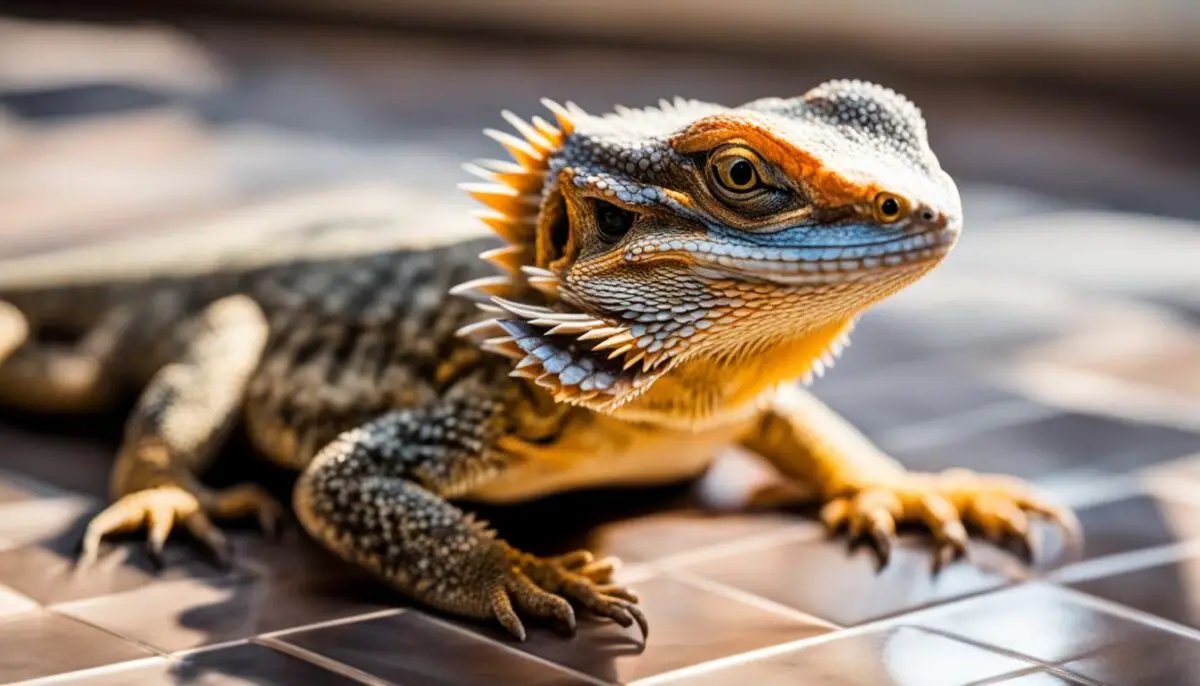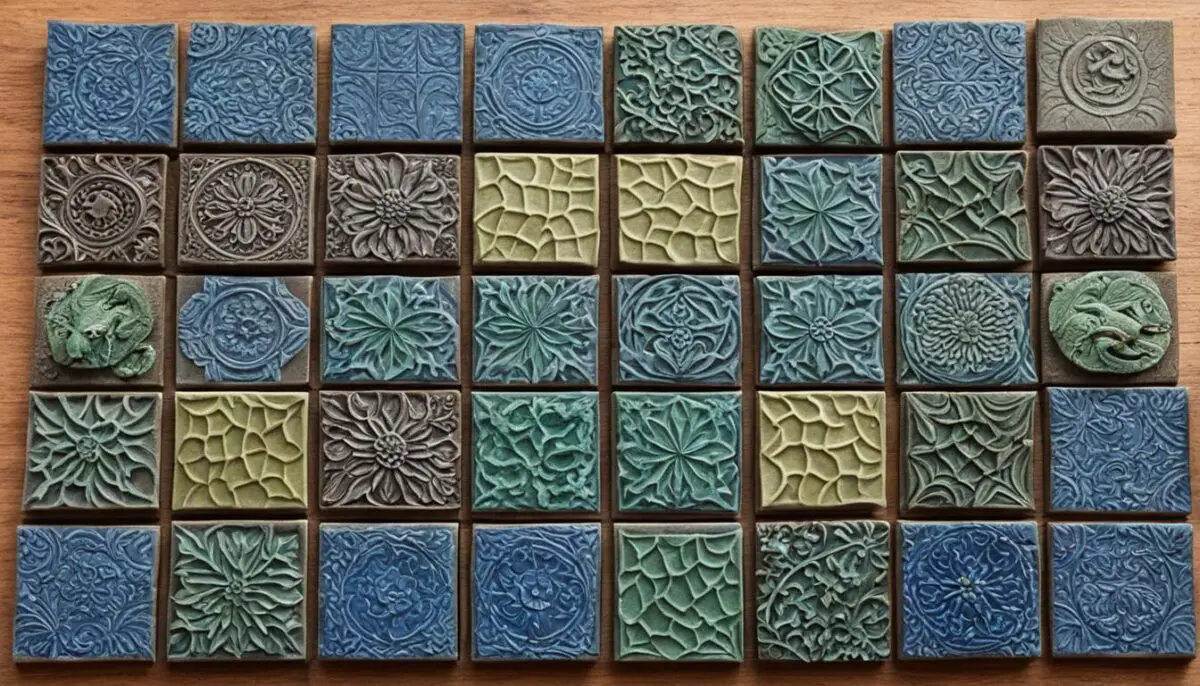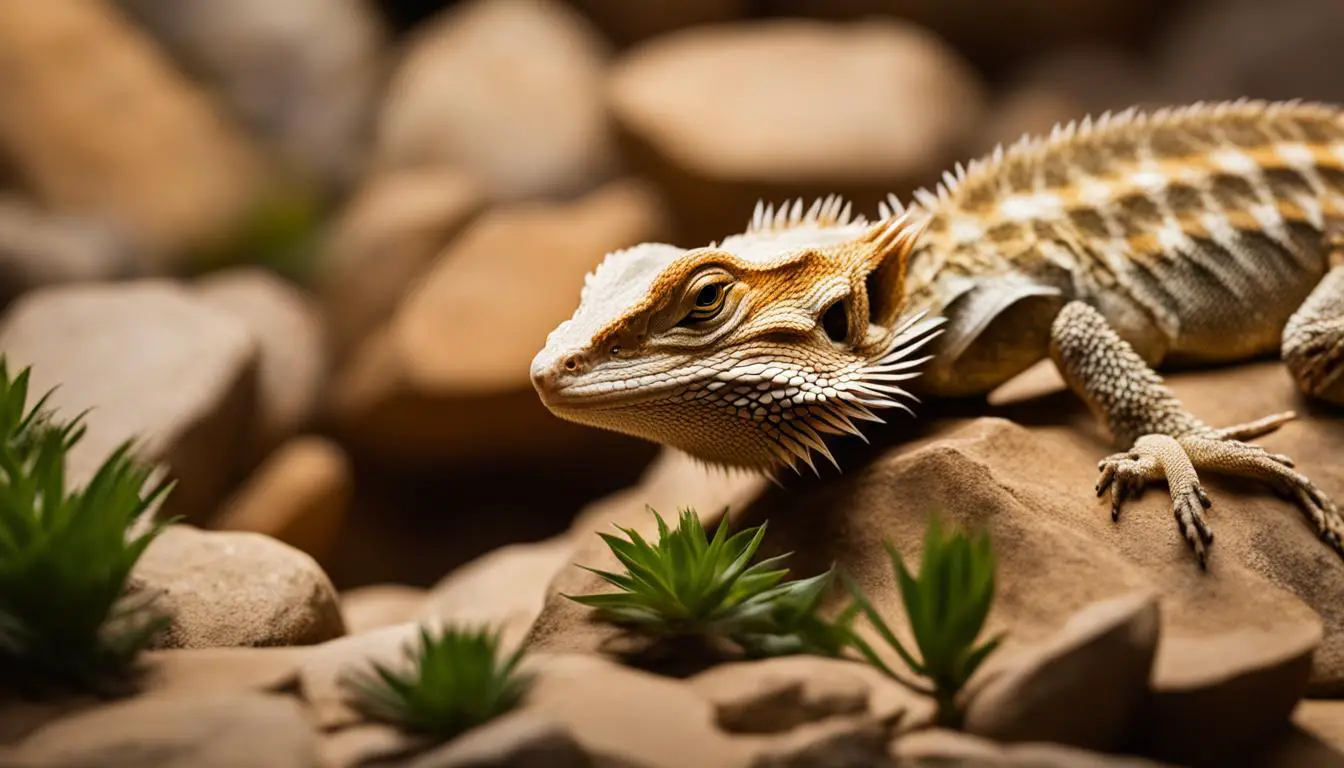When creating a habitat for your bearded dragon, one crucial consideration is the choice of tile substrate. The right tile can provide a stable and hygienic surface for your pet, ensuring their comfort and well-being. With a plethora of options available in the market, selecting the best tile for your bearded dragon tank can be overwhelming. That’s why we’re here to guide you through the process and help you make an informed decision.
Key Takeaways:
- Choosing the right tile substrate is essential for creating a safe and comfortable habitat for your bearded dragon.
- Slate tile and the Zen Mat are popular options, offering benefits such as belly heat, grip, and cushioning for joint support.
- Other cost-effective options like newspaper and paper towels can be used temporarily.
- Consider the pros and cons of solid substrates, like easy cleaning and reduced impaction risk, compared to loose substrates with natural digging opportunities but higher impaction risks.
- Reptile carpet and calcium or vitamin sand are not recommended due to bacterial growth, eye irritation, and impaction risks.
Solid vs. Loose Substrate: Which is Best for Bearded Dragons?
The choice between solid and loose substrate for bearded dragons is a subject of debate. Both options have their pros and cons, so it’s important to weigh the factors and consider the specific needs of your bearded dragon when deciding on the best substrate for their tank.
Pros and Cons of Solid Substrate
- Pros:
- Easy cleaning: Solid substrates like tile provide a smooth surface that is easy to wipe clean, making tank maintenance a breeze.
- Reduced risk of impaction: Solid substrates do not present the same impaction risk as loose substrates, minimizing the chance of your bearded dragon ingesting foreign objects or impactions.
- Cons:
- No natural digging opportunities: Solid substrates do not offer the same opportunities for natural digging and burrowing behavior that loose substrates provide.
Pros and Cons of Loose Substrate
- Pros:
- Natural digging opportunities: Loose substrates like sand and soil mixes allow your bearded dragon to engage in natural digging and burrowing behavior, mimicking their natural habitat.
- Cons:
- Higher risk of impaction: Loose substrates can present a higher risk of impaction, especially if calcium sands or other particles that can be ingested are used. Factors such as dehydration, low basking temperatures, and high gut parasite loads can further contribute to the impaction risk.
Considering these pros and cons, it’s important to strike a balance between providing a solid substrate that is easy to clean and minimizing the impaction risk while still allowing for natural behaviors. It’s recommended to provide enrichment opportunities and other means for natural digging and exploration even if using solid substrate.

| Criteria | Solid Substrate | Loose Substrate |
|---|---|---|
| Easy Cleaning | ✓ | x |
| Reduced Impaction Risk | ✓ | x |
| Natural Digging Opportunities | x | ✓ |
| Higher Impaction Risk | x | ✓ |
Pros and Cons of Using Tile in Bearded Dragon Tanks
Tile is a popular substrate choice for bearded dragon tanks due to its affordability, low maintenance, and reduced risk of impaction. It offers several advantages for creating a safe and comfortable habitat for your bearded dragon.
Advantages of using tile in a bearded dragon enclosure:
- Durability: Tile is a durable material that can withstand the activities of a bearded dragon, such as walking, climbing, and scratching.
- Easy Cleaning: Unlike loose substrates, tile can be easily cleaned using non-toxic disinfectants. It allows for spot cleaning and thorough disinfection when needed.
- Reduced Risk of Impaction: Tile eliminates the risk of bearded dragons ingesting loose substrates, reducing the chances of impaction.
- Visual Appeal: Tile comes in a wide variety of sizes, colors, and textures, allowing you to create a visually appealing enclosure for your bearded dragon.
However, there are some cons to consider when using tile as a substrate:
- Trapped Food and Dirt: Food particles and dirt can get trapped between the tiles, necessitating thorough cleaning to maintain a hygienic environment.
- Porous Tiles: Some types of tiles are porous, which means they can absorb liquids and dirt, leading to stains and the growth of bacteria if not cleaned properly.
- Heat Retention: Tiles have the potential to retain heat, so careful monitoring of the temperature within the enclosure is essential to ensure your bearded dragon’s comfort and safety.
To ensure a perfect fit in the tank, proper measurement and cutting of tiles are important during the installation process. Different types of tiles, such as ceramic, slate, and porcelain, have their own advantages and considerations. Hence, it’s crucial to choose the right type of tile that meets the specific needs of your bearded dragon.

Pros and Cons of Tile in Bearded Dragon Tanks
| Pros | Cons |
|---|---|
| Affordable | Trapped food and dirt |
| Low maintenance | Porous tiles |
| Reduced risk of impaction | Heat retention |
| Visual appeal |
Choosing the right type of tile and properly maintaining the substrate will ensure a comfortable and hygienic environment for your bearded dragon.
Choosing the Right Tile for Your Bearded Dragon Tank
When it comes to creating a comfortable and safe habitat for your bearded dragon, choosing the right tile is crucial. There are various options available, each with its own pros and cons. Let’s explore the different types of tiles, their thickness, textures, adhesive properties, and where to find them.
Types of Tile for Bearded Dragon Tank
There are several popular tile options for bearded dragon tanks, including:
- Ceramic tiles: Ceramic tiles are affordable, easy to clean, and come in a wide range of textures and colors. They provide a smooth and comfortable surface for your bearded dragon to walk on.
- Slate tiles: Slate tiles offer a natural look and excellent grip, making them ideal for bearded dragons that need regular nail trimming. However, they can be porous and absorb impurities, requiring thorough cleaning.
- Porcelain tiles: Porcelain tiles are non-porous, making them easy to clean and resistant to stains. They come in various colors and textures, allowing you to create a visually appealing tank environment.
Tile Thickness and Texture
When selecting tile for your bearded dragon tank, consider the thickness and texture that would best suit your pet’s needs. Thicker tiles provide more durability and insulation. As for texture, you can choose between smooth and textured tiles.
Smooth tiles offer a sleek and easy-to-clean surface, while textured tiles provide better grip for your bearded dragon. The choice between smooth and textured tiles depends on your dragon’s preferences and any special needs, such as nail trimming.
Adhesive vs. Non-Adhesive Tile
When installing tiles in your bearded dragon tank, you have the option of using adhesive or non-adhesive tiles. Non-adhesive tiles are recommended for easy removal and cleaning. They allow you to rearrange or replace tiles without damaging the tank enclosure.
Where to Get Tiles for Bearded Dragon Tank
When looking for tiles for your bearded dragon tank, you can visit home improvement stores like Lowe’s and Home Depot. These stores offer a wide selection of tile options in different sizes. You can also find a variety of tiles on online platforms like Amazon, which provide convenience and cost-effectiveness.

Best Tile Options for Bearded Dragon Substrate
When it comes to creating the perfect substrate for your bearded dragon tank, choosing the right tile is essential. Not only does it provide a sturdy and easy-to-clean surface, but it also adds a decorative touch to your pet’s habitat. Here are some of the best tile options to consider for your bearded dragon’s substrate:
- Trademark Innovations Slate Drink Coasters: These slate drink coasters offer a natural and textured surface that provides excellent grip for your bearded dragon. They are durable, easy to clean, and create a visually appealing look in the tank.
- Silverado Gray 6×6 Marble Tumbled Mosaic Tile: This marble tumbled mosaic tile features a beautiful gray color and a textured surface, making it an ideal choice for bearded dragon substrate. It provides both functionality and aesthetics to enhance your pet’s enclosure.
- Ivory (Light) Travertine 4 x 4 Field Tile: If you prefer a lighter and more neutral tone, the ivory travertine field tile is a great option. It offers a smooth surface with a touch of elegance, while still providing the necessary grip for your bearded dragon.
- Glossy Ceramic Tiles Kit: This glossy ceramic tiles kit comes with a variety of vibrant colors, allowing you to create a customized and visually stimulating environment for your pet. The tiles are easy to clean, making maintenance a breeze.
To set up the tile substrate for your bearded dragon, start by laying a layer of paper towel or newspaper on the base of the tank. This helps catch any dirt or debris and reduces the risk of the tiles scratching or breaking the glass floor. Once the base is prepared, arrange the tiles in a pattern or design of your choice. Ensure that the tiles are securely placed and provide ample coverage for your bearded dragon’s movement.
Spot cleaning should be done on a daily basis to remove any waste or soiling on the tiles. This can be easily done using a reptile-safe disinfectant or a mixture of water and mild soap. Additionally, a thorough monthly cleaning is recommended to maintain hygiene in the tank. This involves washing and disinfecting the tiles, replacing the paper towel or newspaper, and replacing any cracked or dry tiles.
Accurate measurement and cutting of tiles are essential to ensure a proper fit in the tank. Measure the dimensions of your tank carefully and cut the tiles accordingly, leaving space for any decor or basking spots. A precise fit ensures a seamless and visually appealing substrate for your bearded dragon.
With the right choice of tile and proper maintenance, you can create a comfortable and stylish habitat for your bearded dragon. The substrate not only enhances the overall look of the tank but also provides a safe and clean environment for your beloved pet.
Conclusion
When it comes to creating an ideal habitat for your bearded dragon, choosing the best tile for their tank is a crucial decision. It is important to consider various factors such as grip, heat retention, ease of cleaning, and visual appeal. Solid substrates like tile offer numerous advantages, including reduced impaction risk and easy maintenance. On the other hand, loose substrates provide natural digging opportunities, which can enhance your bearded dragon’s overall well-being.
By carefully weighing the pros and cons of each substrate type, you can make an informed decision that suits your bearded dragon’s specific needs. Remember to choose a tile that provides a secure grip for your dragon’s sensitive feet and promotes their natural behaviors. Additionally, maintaining a clean and hygienic tank is essential for your pet’s health. Regular cleaning and maintenance, such as spot cleaning on a daily basis and thorough monthly cleaning, will help ensure a clean and safe environment.
When selecting the right tile for your bearded dragon tank, pay attention to its heat retention properties to avoid excessive temperature fluctuations. Additionally, consider the aesthetic appeal of the tile to create an attractive and visually pleasing enclosure. By following these considerations and providing proper care, you can create a comfortable and stylish habitat for your beloved bearded dragon.
FAQ
What are some popular tile options for a bearded dragon tank?
Some popular tile options for a bearded dragon tank include slate tile and the Zen Mat.
What are the pros and cons of using solid substrate versus loose substrate for bearded dragons?
Solid substrates like tile provide easy cleaning and reduce the risk of impaction, while loose substrates offer natural digging opportunities but have a higher risk of impaction.
What are the advantages and disadvantages of using tile in bearded dragon tanks?
The advantages of using tile in bearded dragon tanks include affordability, low maintenance, and reduced risk of impaction. However, food and dirt can get trapped between the tiles, requiring thorough cleaning.
What factors should be considered when choosing tile for a bearded dragon tank?
Factors to consider when choosing tile for a bearded dragon tank include the type of tile (such as ceramic, slate, or porcelain), tile thickness, whether to grout the tiles or not, and whether to choose smooth or textured tiles for better grip.
What are some recommended tile options for bearded dragon substrate?
Some recommended tile options for bearded dragon substrate include trademark innovations slate drink coasters, silverado gray 6×6 marble tumbled mosaic tile, ivory (light) travertine 4 x 4 field tile, and glossy ceramic tiles kit.
How should tile substrate be set up in a bearded dragon tank?
When setting up tile substrate in a bearded dragon tank, it is important to lay a layer of paper towel or newspaper on the base of the enclosure before placing the tiles. This helps catch dirt and reduces the risk of the tiles breaking the glass floor.
How should tile substrate for bearded dragons be cleaned and maintained?
Spot cleaning should be done daily, and a thorough monthly cleaning should involve washing and disinfecting the tiles, replacing the paper towel/newspaper, and replacing any dry tiles. Accurate measurement and cutting of tiles are important to ensure a proper fit in the tank.
What should I consider when choosing the best tile for my bearded dragon tank?
When choosing the best tile for your bearded dragon tank, you should consider factors like grip, heat retention, ease of cleaning, and visual appeal.
What are the advantages of using tile substrate in a bearded dragon tank?
The advantages of using tile substrate in a bearded dragon tank include affordability, reduced risk of impaction, and ease of maintenance.
How can I find the right tile for my bearded dragon tank?
You can find the right tile for your bearded dragon tank at home stores like Lowe’s and Home Depot, or through online platforms like Amazon.


